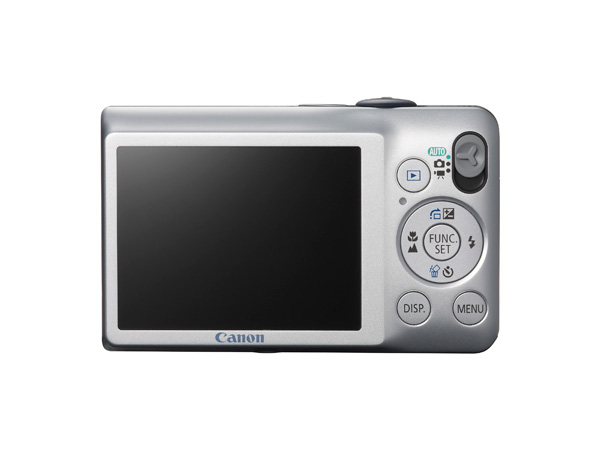 Why You Can Trust CNET
Why You Can Trust CNET Canon IXUS 105 IS review: Canon IXUS 105 IS
The Canon IXUS 105 IS can't do too much wrong if all you want to do is point and shoot.
Design
The IXUS 105 IS shares many stylistic similarities with previous cameras in Canon's ultra-compact range. It's most similar to the IXUS 95 IS from last year, housed in a more boxy casing than its sleek stablemates the 130 IS and 300 HS.
The Good
The Bad
The Bottom Line
Measuring 55.8x90.5x21.2mm and weighing 117g, it's light enough to throw around in a handbag or pocket, but chunky enough to make sure it doesn't fall prey to slippery fingers. It comes in silver, pink, green and brown, enough variety to satisfy even the pickiest photographer. Controls are easy enough for a first-time photographer to use, with a standard arrangement of power and shutter buttons up top, and a mode switch at the back that can flip the camera into automatic, program or movie mode.

The Canon IXUS 105 IS has a simple arrangement of shooting controls and buttons on the back. (Credit: Canon)
Features
Being the lowest rung on the IXUS ladder means that this camera misses out on a few features that crop up on more expensive models, but fortunately nothing too important for users looking for a typical point-and-shoot. Inside is a 12.1-megapixel sensor and the camera has a 4x optical zoom with a 28mm wide-angle lens, adequate enough for most needs. One pleasing thing to see on this camera is the wide optics; f/2.8, which means in theory that the lens can let more light in, ideal for lower-light photography and achieving a blurred-background look in macro and portrait photography.
There is no HD video, but then again it's debatable whether people in the market for this sort of compact camera really needs that capability. Let's compare this camera to the Nikon Coolpix S3000, one of its closest competitors on specifications:
| Canon IXUS 105 IS | Nikon Coolpix S3000 |
|---|---|
| 12 megapixels | 12 megapixels |
| 2.7-inch LCD | 2.7-inch LCD |
| 28mm wide-angle lens | 27mm wide-angle lens |
| No HD video recording | No HD video recording |
| Optical image stabilisation | Electronic image stabilisation |
| RRP AU$329 | RRP AU$199 |
A comparison of images taken with the Canon 105 IS and Nikon S3000, both taken at 4x optical zoom. The images above are excerpts from a 100 per cent crop of each image. (Credit: Alexandra Savvides/CNET Australia)
In automatic mode, users give most control over to the camera, with just a few shooting selections available: choosing the image size, flash control and self timer. In program mode, a little more control is opened up. Scene modes become available, including portrait, night snapshot, kids and pets, indoor and face self-timer. Users can also choose full program mode, which will allow ISO adjustments, colour controls, metering options, continuous shooting and image size. The IXUS 105 IS gives six different image sizes, from the full 12-megapixel resolution, three medium resolutions (8, 5 and 2 megapixels), a small size (VGA resolution) and widescreen shooting in the 16:9 aspect ratio.
Canon's low light mode (renamed from High ISO in previous versions of the camera) takes reduced resolution shots at 2 megapixels from the ISO range 400-6400.
Performance
The 105 IS starts up and takes its first shot within 1.9 seconds without flash, and shutter lag is about average for a camera of this class at 0.5 second. Shot-to-shot time is reasonably slow, with the 105 IS managing to give just 0.6 shots per second in continuous mode. Time between shots is only average, too; 2.7 seconds without flash, 4.9 seconds with flash.
Image quality
Pictures from the 105 IS were the strongest aspect of the camera. Colours and overall sharpness was particularly good for a camera of this class. There were aspects of overexposure in tricky lighting situations though, and some evidence of purple fringing. For casual point-and-shooters though, this won't matter too much.
Comparing colour rendition with the Nikon S3000 side by side shows punchier colours from the Canon, as can be seen below. Pushing the camera to ISO 800 and beyond resulted in a fair amount of coloured noise.
(Credit: Alexandra Savvides/CNET Australia)
At full extension of the 4x optical zoom lens, images still appeared sharp. There was also little to no barrel distortion evident. Macro mode delivered pleasing results, as can be seen below, with a full magnification crop inset.
(Credit: Alexandra Savvides/CNET Australia)
Video quality was acceptable for a compact of this class and at VGA resolution. Note there is no optical zoom while filming.
Conclusion
The Canon IXUS 105 IS can't do too much wrong if all you want to do is point and shoot, but the price is a bit steep considering the only real feature that sets it apart from other cameras is image quality.


